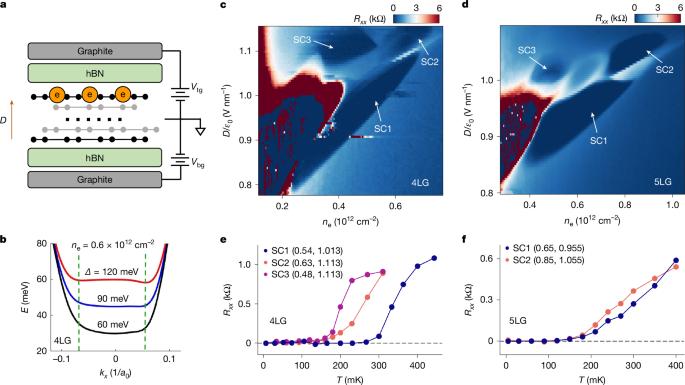Signatures of chiral superconductivity in rhombohedral graphene
IF 48.5
1区 综合性期刊
Q1 MULTIDISCIPLINARY SCIENCES
引用次数: 0
Abstract
Chiral superconductors are unconventional superconducting states that break time-reversal symmetry spontaneously and typically feature Cooper pairing at non-zero angular momentum. Such states may host Majorana fermions and provide an important platform for topological physics research and fault-tolerant quantum computing1–7. Despite intensive search and prolonged studies of several candidate systems8–26, chiral superconductivity has remained elusive so far. Here we report the discovery of robust unconventional superconductivity in rhombohedral tetralayer and pentalayer graphene without moiré superlattice effects. We observed two superconducting states in the gate-induced flat conduction bands with Tc up to 300 mK and charge density ne down to 2.4 × 1011 cm−2 in five devices. Spontaneous time-reversal-symmetry breaking (TRSB) owing to orbital motion of the electron is found and several observations indicate the chiral nature of these superconducting states, including: (1) in the superconducting state, Rxx shows magnetic hysteresis in varying out-of-plane magnetic field B⊥—absent from all other superconductors; (2) the superconducting states are robust against in-plane magnetic field and are developed within a spin-polarized and valley-polarized quarter-metal (QM) phase; (3) the normal states show anomalous Hall signals at zero magnetic field and magnetic hysteresis. We also observed a critical B⊥ of 1.4 T, higher than any graphene superconductivity, which indicates a strong-coupling superconductivity close to the Bardeen–Cooper–Schrieffer (BCS)–Bose–Einstein condensate (BEC) crossover27. Our observations establish a pure carbon material for the study of topological superconductivity, with the promise to explore Majorana modes and topological quantum computing. Observations indicating the chiral nature of superconducting states in five rhombohedral tetralayer and pentalayer graphene devices without moiré superlattice effects are reported, establishing a pure carbon material for the study of topological superconductivity.

菱形石墨烯的手性超导特征
手性超导体是一种非常规的超导态,它自发地打破了时间反转对称性,并且典型地以非零角动量的库珀对为特征。这种状态可能承载马约拉纳费米子,并为拓扑物理研究和容错量子计算提供重要平台1 - 7。尽管对几个候选系统进行了深入的研究,但手性超导至今仍是一个谜。在这里,我们报告了在没有摩尔超晶格效应的四面体和五层石墨烯中发现的强大的非常规超导性。在5个器件中,我们观察到两种超导态,Tc高达300 mK,电荷密度ne低至2.4*1011 cm-2。由于电子的轨道运动,发现了自发的时间逆对称破缺,并且一些观察表明了这些超导态的手性,包括:1。在超导状态下,Rxx在所有其他超导体都不存在的面外磁场B⊥中表现出磁滞;2. 超导态对面内磁场具有鲁棒性,并在自旋极化和谷极化四分之一金属相内发展;3. 正常状态在零磁场和磁滞时出现异常霍尔信号。我们还观察到临界B⊥为1.4特斯拉,高于任何石墨烯超导性,并表明强耦合超导性接近BCS-BEC交叉27。我们的观察为拓扑超导研究建立了一种纯碳材料,有望探索马约拉纳模式和拓扑量子计算。
本文章由计算机程序翻译,如有差异,请以英文原文为准。
求助全文
约1分钟内获得全文
求助全文
来源期刊

Nature
综合性期刊-综合性期刊
CiteScore
90.00
自引率
1.20%
发文量
3652
审稿时长
3 months
期刊介绍:
Nature is a prestigious international journal that publishes peer-reviewed research in various scientific and technological fields. The selection of articles is based on criteria such as originality, importance, interdisciplinary relevance, timeliness, accessibility, elegance, and surprising conclusions. In addition to showcasing significant scientific advances, Nature delivers rapid, authoritative, insightful news, and interpretation of current and upcoming trends impacting science, scientists, and the broader public. The journal serves a dual purpose: firstly, to promptly share noteworthy scientific advances and foster discussions among scientists, and secondly, to ensure the swift dissemination of scientific results globally, emphasizing their significance for knowledge, culture, and daily life.
 求助内容:
求助内容: 应助结果提醒方式:
应助结果提醒方式:


